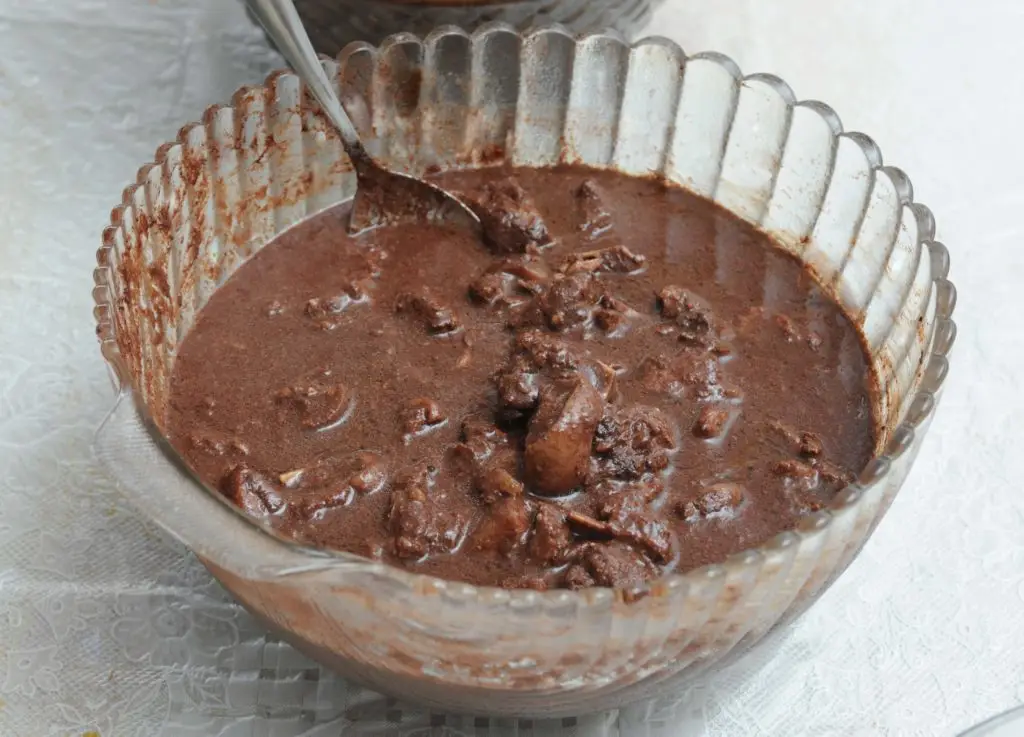Fritada: Pork, Beef or Venison Blood Stew

Table of Contents
Share This
Description
Fritada, from the Spanish verb “fritar”, means fried dish. In Guam, fritada is more a blood stew than a fried dish and is made up of chopped up internal organs of pigs, cattle, or deer cooked in fat and blood with onions, vinegar and spices.
History
Origin
The earliest record of a blood soup goes back to ancient Greece. The Spartan meal of melas zomos, or black soup, was made of boiled pigs’ blood, pork, and vinegar.
It is probable that the source of the name fritada for the Guam dish came from a dish of the same name in Monterrey, Mexico where it refers to a stew made with the innards and blood of a young lamb. The origin of this Mexican dish is chanfaina from Extremadura, Spain.
A similar dish exists in the Philippines called dinuguan. It is a stew of blood, offal and meat simmered in rich, spicy gravy of pig blood, garlic, chili and vinegar. The term dinuguan comes from the Filipino word dugo meaning “blood.”
Evolution
Pork, beef and deer were not a part of the traditional CHamoru diet. It was reported by the Legazpi expedition in 1565 that the natives of Guam:
were not accustomed to eat flesh, nor would the prisoners, who were carried away by our ship, eat any food except fish.
In the early 1700s the Spanish introduced pigs, cattle and deer to the Mariana islands, and meat into the CHamoru diet. Fritada came to Guam during the Spanish era most likely from Mexico. The Mexican fritada recipe was altered to include ingredients that were readily available in Guam such as pork instead of lamb. It is also probable that the dish has some Filipino influence.
In the past, fritada was only made after butchering an animal. This was due in part to the absence of refrigeration, the perishable nature of the ingredients and the economic practice of using as much of the animal as possible. This dish was also served at roofing parties.
Today the ingredients for fritada can be purchased frozen in a grocery store. Fritada can be found not only on fiesta tables, but also at island restaurants and homes.
Preparation
Traditionally the preparation of fritada was a family affair. The men would butcher the animal and collect the blood, the women would clean the ingredients and prepare the fritada. Men are also known to prepare this dish.
Placement on table
Fritada is placed on the totche (meat) section of the table. This is directly after the åggon (starch) section and before the fish section.
Recipe
Fritada
- ½ onion
- Salt
- Black Pepper
- Blood
- 4 cloves garlic
- Vinegar
- Small and large intestines
- Heart
- Liver
- Pancreas
Clean the intestine and the pancreas well.
Cut open the intestine and pancreas and scrub both very well until clean. Scrub in coconut oil or salad oil.
Wash with boiling water, vinegar and salt.
Wash liver and heart.
Cut liver, heart, pancreas and intestines into ½ inch pieces and place in a large pan.
Slice onions and garlic and add to pan with liver, heart, pancreas and intestines.
Add 3 tablespoons vinegar, 1 teaspoon pepper and 1 Tablespoon salt to pan and mix and cook.
When meat is cooked and dry, add the blood stirring and mixing constantly. If you do not mix continually the blood will form into a ball.
Cook all together until the blood turns black and all is combined into a solid mixture.
Cook about 15 minutes.
Add 1 cup of cold water – boil 1 minute.
Serve with rice.
* Recipe from Recipes from Guam, 1954 by Alex Maxwell
